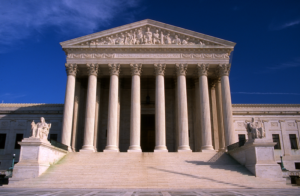
by Wilton H. Strickland
In my previous post I discussed what an attorney might do when confronted with a complaint that is legally deficient. However, an attorney often faces a slightly different challenge, namely how to remove a perfectly valid complaint from state court to federal court.
Removal is popular for many reasons, such as avoidance of possible local bias, but the options for removal are few. According to 28 U.S.C. § 1441, removal is available only if a state-court complaint could originally have been filed in federal court. From a practical perspective this means that unless the complaint asserts a federal cause of action, your only hope is diversity jurisdiction as defined under 28 U.S.C. § 1332. (Other grounds for removal are narrow and infrequent.)
As any first-year law student knows, diversity jurisdiction requires showing that the amount in controversy exceeds $75,000 and that the opposing parties are of completely diverse citizenship. If just one defendant is from the same state as a plaintiff, or if just one defendant is from the same state where the action is pending, there is no allowable removal.
What separates the law student from the practitioner, however, is the ability to read between the lines. It is possible to obtain diversity removal even if the complaint designates non-diverse parties. I know this because I have done it, and you can too if any of the following circumstances warrant:
The Complaint Names Non-Diverse “Doe” Defendants
State-court complaints often name a foreign business entity as the primary defendant, yet also designate “John Does” or “Jane Does” as anonymous human defendants from the forum state. While such a complaint appears immune to diversity removal, you should take note that the current version of 28 U.S.C. § 1441(b)(1) nips this in the bud by ignoring anonymous parties for removal purposes: “In determining whether a civil action is removable on the basis of the jurisdiction under section 1332(a) of this title [i.e., diversity], the citizenship of defendants sued under fictitious names shall be disregarded.” (Emphasis added.)
The Complaint Shows “Fraudulent Joinder” Of Non-Diverse Defendants
While non-diverse defendants may appear in the style of the case, their presence will not defeat removal to federal court if the complaint fails to state a cause of action against them according to the settled rules of the state in question. See Morris v. Princess Cruises, Inc., 236 F.3d 1061, 1067 (9th Cir. 2001); Ullah v. BAC Home Loans Servicing LP, No. 12-12557, 2013 U.S. App. LEXIS 16995, at *4-*6 (11th Cir. Aug. 16, 2013).
A strong indicator of fraudulent joinder is if the complaint asserts no specific allegations against the non-diverse defendant. The real acid test, though, is whether any actual or possible allegations against that defendant would survive dismissal in state court. For example, if the defendant already has entered a settlement with the plaintiff regarding the issues alleged, or if the defendant truly is not subject to the personal jurisdiction of the state court, removal to federal court remains possible.
The Complaint Names “Nominal Parties” As Non-Diverse Defendants
Perhaps joinder of a non-diverse defendant is entirely legitimate, yet that defendant has no interest in the outcome of the case and is present for mere technical reasons. Such a “dispensable” or “nominal” party will also be ignored for purposes of diversity removal. See Strotek Corp. v. Air Transp. Ass’n of Am., 300 F.3d 1129, 1133 (9th Cir. 2002); Hernandez v. Ferris, 917 F. Supp. 2d 1224, 1227 (M.D. Fla. 2012).
This tends to occur when financial institutions hold disputed assets, and who might otherwise file an interpleader complaint to step out of the proceedings; however, the test for a “nominal party” is flexible and applies to any party whose absence would not hinder the adjudication of other parties’ rights. Id.
The Complaint Names Non-Diverse Defendants Whose Interests Are Aligned With The Plaintiff’s
Strange as it sounds, a defendant often can benefit from a plaintiff’s victory. For example, a shareholder lawsuit naming the corporation and various directors as defendants might be in the corporation’s best interest. See, e.g., In re Digimarc Corp. Derivative Litigation, 549 F.3d 1223, 1234 (9th Cir. 2008). In similar fashion, a defendant with liability insurance has every reason to hope that the plaintiff will succeed in obtaining coverage from the co-defendant insurer. See City of Vestavia Hills v. General Fid. Ins. Co., 676 F.3d 1310, 1313-14 (11th Cir. 2012).
In these types of situations a federal court can “re-align” the interested defendant as a plaintiff and thereby allow removal even if it were otherwise impossible. As one court explained it:
[F]ederal courts are required to re-align the parties in an action to reflect their interests in the litigation. The parties themselves cannot confer diversity jurisdiction upon the federal courts by their own designation of plaintiffs and defendants. . . . This Court concludes that the converse of this principle – that parties cannot avoid diversity by their designation of the parties – is also true. . . . Where the parties’ interests are the same, we have held that those parties must be aligned together and have reversed a district court’s failure to do so, even where the parties’ interests were in opposition outside of the issues raised in the subject action.
City of Vestavia Hills, 676 F.3d at 1313-14 (emphasis added) (citations omitted).
Lessons
Do not give up hope of diversity removal to federal court simply because the complaint designates non-diverse defendants. If the non-diverse defendant bears a fictitious name, or if you scratch the surface of the complaint to find that things are not as they appear, removal might still be available.
Of course, I have not discussed other aspects of diversity removal such as how to affix the amount in controversy or when to file the removal petition. Perhaps in a future post!


